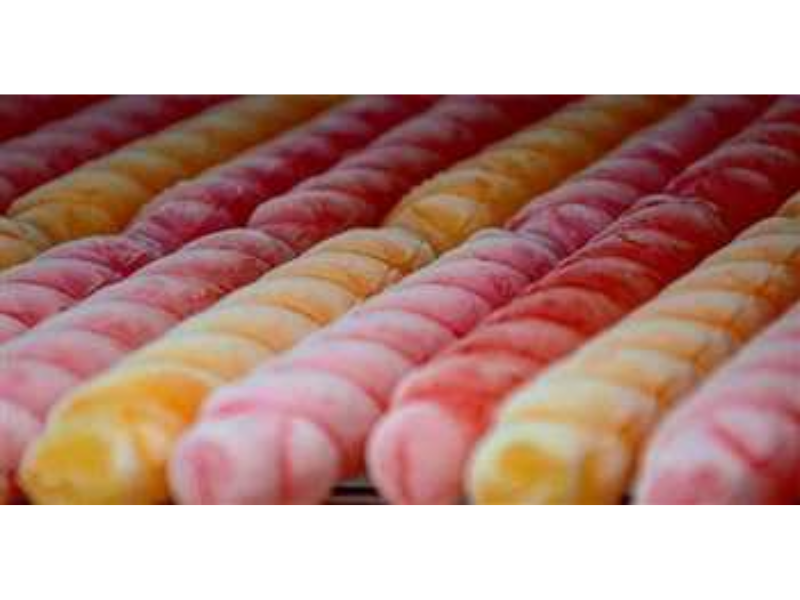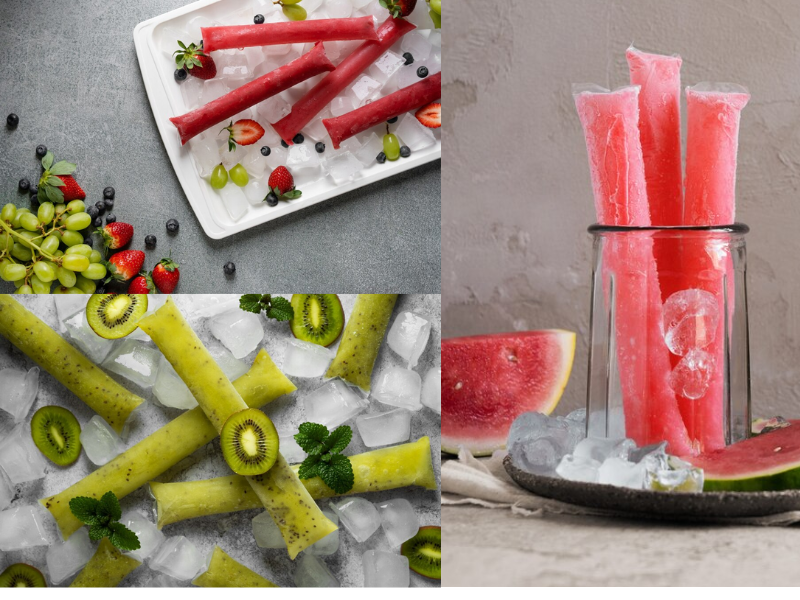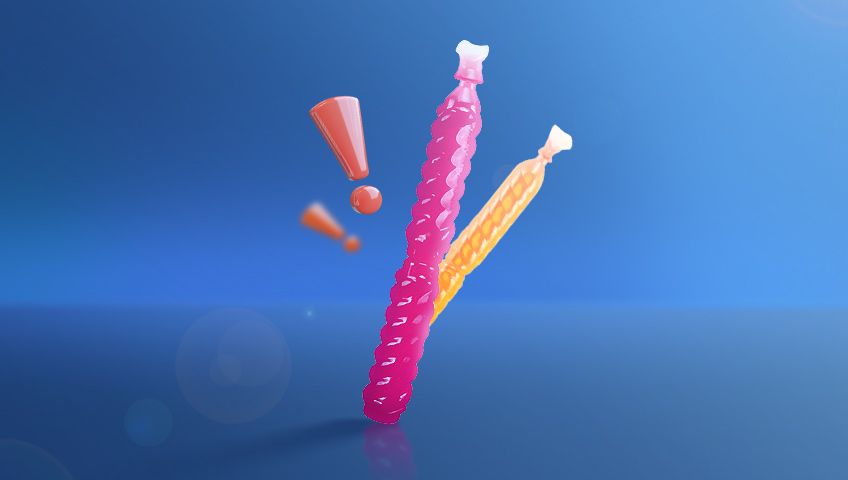2025.12.09
Ice pop, also known as " Freezies," is a colorful and popular frozen treat that many people, especially children, enjoy. Its fruity appearance or flavors like orange and cherry might create the impression that it contains fruit or natural ingredients. However, ice pop is actually an ultra-processed product classified under frozen desserts, typically made from a combination of water, various sweeteners, food colorings, and flavorings, offering little nutritional value.

History
The human desire for cold treats during hot seasons is not a recent phenomenon. Historical evidence shows that in ancient civilizations like Rome and Egypt, the wealthy classes used natural ice from the mountains to prepare cold and refreshing drinks by adding ingredients such as honey or fruit syrups.
The emergence of ice pops as a frozen product is rooted in the invention of the ice pop or popsicle, which first appeared in the early 20th century in the United States. According to historical accounts, in 1905, an eleven-year-old boy named Frank Epperson prepared a sweet drink after a day of playing. Accidentally, while stirring it with a stick, he left the drink outdoors and forgot to bring it inside. As a result, the cold night caused the mixture in the glass, along with the stick, to freeze.
The next morning, upon encountering this phenomenon, Frank curiously tried to remove the frozen drink from the glass. This experience led to the creation of the first wooden stick ice pop. He named this treat "Epsicle," a combination of "Ep" from his last name, Epperson, and "sicle" from "icicle," thus meaning "Epperson's icicle" or "Epperson's ice".
In 1923, Frank Epperson decided to offer this product to the public on a larger scale and sold it in a busy recreational area. Its popularity grew quickly, and in 1924 he officially patented his creation. Eventually, upon his children's suggestion, Frank Epperson registered the product under the simpler name "Popsicle".
With the establishment of Popsicle's position in the United States market and its patent, this simple and affordable treat quickly became one of the most popular summer desserts. Similar products with various names were also produced and sold in other parts of the world.
In Iran, the exact date of the introduction of this type of treat is unclear, but evidence suggests that homemade frozen drinks, such as sour cherry syrup or frozen lemonade, became common from the 1330s and 1340s in the Iranian solar calendar. Over time, companies in Iran began industrial production of " Ice pops" and in the following decades, it became a widely consumed treat, especially in the summer, available in various flavors and colors across the market.
Ingredients of Ice Pops and Their Potential Dangers
Ice pops are typically made from a combination of water, sweeteners, colorings, and flavorings. In some cases, stabilizers and food acids that regulate pH are added for various reasons, such as maintaining texture uniformity, color stability, preventing microbial growth, and so on. After the initial solution is prepared, this mixture is transferred to special molds, which are thin plastic wrappers, and frozen at freezing temperatures.
Some of the raw materials used in the preparation of ice pops, if used in the production process in quantities higher than the determined permissible limits, or if consumed frequently and excessively by consumers, especially children, can pose health risks. These risks include:
- Food Colorings
In the preparation of ice pops, attractive colors such as red, orange, etc., are commonly used. Although these colors are effective in increasing the visual appeal of ice pops, they have no nutritional value, and some of them may even become contaminated with heavy metals during various stages of the process. As a result, they may contain excessive amounts of hazardous heavy metals such as lead, mercury, cadmium, and arsenic, exceeding the permissible limits.
If the amount of heavy metals present in the food colorings used in ice pop production is not checked, it is possible for colors contaminated with excessive amounts of heavy metals to enter the production process. Since the Iranian national standard for ice pops does not include a test to measure the amount of heavy metals in the final product, if contaminated colors are used, heavy metals can enter the final product uncontrolled and be offered to the market.
Food colorings can be associated with a range of negative health effects in humans, including allergic reactions, gastrointestinal and kidney disorders, bowel inflammation, damage to genetic material (DNA), and even an increased risk of certain cancers. Considering that children have a high tendency to consume ice pops and, on the other hand, due to their lower weight and weaker immune systems, this age group may be more sensitive to heavy metals, this issue is of greater importance for children. The presence of heavy metals in industrial ice pops can endanger children's health and lead to problems such as behavioral changes, mood swings, impaired concentration, and hyperactivity.
- Sweeteners
Sweeteners are one of the main components of ice pops, playing a key role in the flavor of this product. In the production process of ice pops, various types of sugars and sweetening syrups are used, each with its own specific characteristics, and excessive consumption of any of them can be associated with significant negative health effects. These sweeteners include:
- Sucrose
Also known as white sugar, sucrose is one of the most widely used sweeteners. It is composed of two simple sugars called glucose and fructose. After consumption and entry into the body, it is first broken down into these two simple sugars. Despite its widespread use and pleasant taste, excessive consumption of sucrose, like other sugars, can lead to serious negative consequences such as weight gain, tooth decay, impaired blood sugar regulation, increased risk of type 2 diabetes, and heart diseases.
- Glucose
Glucose is a simple sugar and the main source of energy in the body, rapidly absorbed from the digestive system and usable by all cells. However, glucose has a high glycemic index, meaning that after consumption, it quickly raises blood sugar levels, followed by a significant increase in insulin secretion from the pancreas. This sudden increase and subsequent rapid drop in blood sugar can cause feelings of fatigue and premature hunger, leading to overeating, weight gain, and fat accumulation in the abdominal area. In addition, frequent and excessive consumption of glucose may, in the long term, reduce the sensitivity of cells to insulin and increase the risk of insulin resistance.
- High-Fructose Corn Syrup (HFCS)
High-fructose corn syrup is an artificial sweetener derived from corn, containing a high proportion of fructose (usually 55%). Due to its low cost, pleasant taste, and liquid state, it is used in many food products, including ice pops. Since fructose is metabolized only in the liver, excessive consumption can lead to fat accumulation in the liver, non-alcoholic fatty liver disease, increased uric acid levels and consequently gout (a type of inflammatory arthritis), abdominal obesity, insulin resistance, and an increased risk of heart diseases. Furthermore, high-fructose corn syrup is weak in stimulating feelings of fullness and can contribute to overeating.
- Inverted Sugar Syrup
Inverted sugar syrup is a type of liquid sweetener produced by breaking down sucrose into its component glucose and fructose through heating with food acids like citric acid. This syrup is widely used in ice pops and other products due to its higher sweetness, ability to retain moisture, and long shelf life. Despite its functional advantages, excessive consumption can cause blood sugar fluctuations, weight gain, tooth decay, fatigue, and an increased risk of type 2 diabetes.
Overall, all these sweeteners lack essential micronutrients such as vitamins, minerals, and fiber, and therefore only provide temporary energy to the body and have no nutritional value.
- Food Flavorings
Flavorings are common compounds used to improve the aroma and taste of food products, including ice pops. These substances are broadly divided into natural and artificial categories. Natural flavorings are extracted from plant or animal sources, while artificial flavorings are produced using chemical substances.
In general, flavorings, if consumed continuously or in high amounts, can cause side effects such as skin or respiratory allergies, irritation of the digestive system, and even hormonal disorders or carcinogenicity in some specific compounds.
Homemade Alternatives to Ice Pops
Ice pops, as an attractive, tasty, and refreshing treat, especially in the summer, have many fans. However, industrial ice pops usually contain high amounts of sugar, artificial food colorings, and chemical flavorings that have no nutritional value, and their continuous and excessive consumption can threaten health, especially in children. Therefore, using homemade ice pops made with natural and nutritious ingredients can be a healthy, beneficial, and safe alternative.
- Natural Fruit Ice Pops
One way to prepare homemade ice pops is to use fresh and natural fruits. In this method, you can use the juice or puree of fruits such as watermelon, cantaloupe, kiwi, or strawberries, and add a small amount of honey or date syrup to create a mild sweet taste. This type of ice pop is completely free of artificial colors, essences, and sweeteners, and at the same time, it is a natural source of vitamins, fiber, and antioxidants.
If the goal is to prepare a more nutritious and filling ice pop, you can also add some yogurt or milk to the above mixture. This change increases the amount of protein, calcium, and beneficial fats in the final product, making it a more suitable option for children and adolescents.
In addition, instead of fruit puree or juice, you can use traditional homemade syrups (such as Sekanjabin syrup, sour cherry, strawberry, rosewater, etc.).
Note: It is better not to use industrial syrups for making homemade ice pops, because they may also contain sweeteners, food colorings, and various flavorings like industrial ice pops.

- Chia Seed and Fruit Ice Pops
To prepare ice pops, you can combine natural fruit juices with a little chia seeds. In addition to an attractive appearance, this combination can also help with hydration in the summer.
Final Word
Ice pops are among the treats that are highly popular due to their sweet taste and cooling sensation. However, industrial ice pops usually have little nutritional value. Therefore, using homemade and natural alternatives is a healthier and smarter option. These alternatives, in addition to providing a sense of freshness and coolness, can also supply part of the body's need for nutrients. By making informed choices and preparing ice pops at home, you can both enjoy the delicious taste of this treat and help your family's health.


